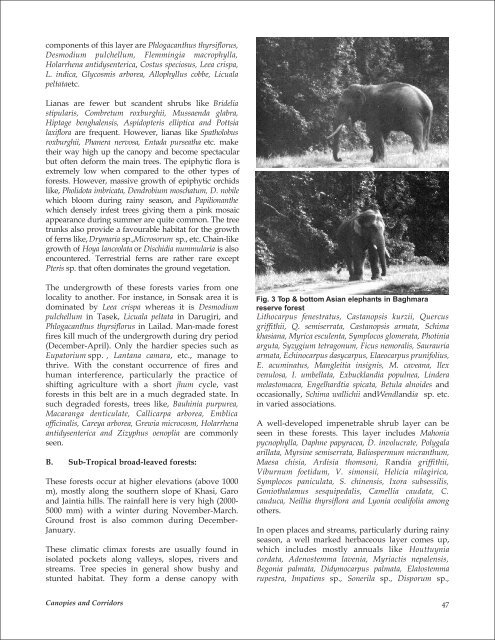Canopies and Corridors - International Fund for Animal Welfare
Canopies and Corridors - International Fund for Animal Welfare
Canopies and Corridors - International Fund for Animal Welfare
Create successful ePaper yourself
Turn your PDF publications into a flip-book with our unique Google optimized e-Paper software.
components of this layer are Phlogacanthus thyrsiflorus,<br />
Desmodium pulchellum, Flemmingia macrophylla,<br />
Holarrhena antidysenterica, Costus speciosus, Leea crispa,<br />
L. indica, Glycosmis arborea, Allophyllus cobbe, Licuala<br />
peltataetc.<br />
Lianas are fewer but sc<strong>and</strong>ent shrubs like Bridelia<br />
stipularis, Combretum roxburghii, Mussaenda glabra,<br />
Hiptage benghalensis, Aspidopteris elliptica <strong>and</strong> Pottsia<br />
laxiflora are frequent. However, lianas like Spatholobus<br />
roxburghii, Phanera nervosa, Entada purseatha etc. make<br />
their way high up the canopy <strong>and</strong> become spectacular<br />
but often de<strong>for</strong>m the main trees. The epiphytic flora is<br />
extremely low when compared to the other types of<br />
<strong>for</strong>ests. However, massive growth of epiphytic orchids<br />
like, Pholidota imbricata, Dendrobium moschatum, D. nobile<br />
which bloom during rainy season, <strong>and</strong> Papilionanthe<br />
which densely infest trees giving them a pink mosaic<br />
appearance during summer are quite common. The tree<br />
trunks also provide a favourable habitat <strong>for</strong> the growth<br />
of ferns like, Drymaria sp.,Microsorum sp., etc. Chain-like<br />
growth of Hoya lanceolata or Dischidia nummularia is also<br />
encountered. Terrestrial ferns are rather rare except<br />
Pteris sp. that often dominates the ground vegetation.<br />
The undergrowth of these <strong>for</strong>ests varies from one<br />
locality to another. For instance, in Sonsak area it is<br />
dominated by Leea crispa whereas it is Desmodium<br />
pulchellum in Tasek, Licuala peltata in Darugiri, <strong>and</strong><br />
Phlogacanthus thyrsiflorus in Lailad. Man-made <strong>for</strong>est<br />
fires kill much of the undergrowth during dry period<br />
(December-April). Only the hardier species such as<br />
Eupatorium spp. , Lantana camara, etc., manage to<br />
thrive. With the constant occurrence of fires <strong>and</strong><br />
human interference, particularly the practice of<br />
shifting agriculture with a short jhum cycle, vast<br />
<strong>for</strong>ests in this belt are in a much degraded state. In<br />
such degraded <strong>for</strong>ests, trees like, Bauhinia purpurea,<br />
Macaranga denticulate, Callicarpa arborea, Emblica<br />
officinalis, Careya arborea, Grewia microcosm, Holarrhena<br />
antidysenterica <strong>and</strong> Zizyphus oenoplia are commonly<br />
seen.<br />
B. Sub-Tropical broad-leaved <strong>for</strong>ests:<br />
These <strong>for</strong>ests occur at higher elevations (above 1000<br />
m), mostly along the southern slope of Khasi, Garo<br />
<strong>and</strong> Jaintia hills. The rainfall here is very high (2000-<br />
5000 mm) with a winter during November-March.<br />
Ground frost is also common during December-<br />
January.<br />
These climatic climax <strong>for</strong>ests are usually found in<br />
isolated pockets along valleys, slopes, rivers <strong>and</strong><br />
streams. Tree species in general show bushy <strong>and</strong><br />
stunted habitat. They <strong>for</strong>m a dense canopy with<br />
<strong>Canopies</strong> <strong>and</strong> <strong>Corridors</strong><br />
Fig. 3 Top & bottom Asian elephants in Baghmara<br />
reserve <strong>for</strong>est<br />
Lithocarpus fenestratus, Castanopsis kurzii, Quercus<br />
griffithii, Q. semiserrata, Castanopsis armata, Schima<br />
khasiana, Myrica esculenta, Symplocos glomerata, Photinia<br />
arguta, Syzygium tetragonum, Ficus nemoralis, Saurauria<br />
armata, Echinocarpus dasycarpus, Elaeocarpus prunifolius,<br />
E. acuminatus, Mangleitia insignis, M. caveana, Ilex<br />
venulosa, I. umbellata, Exbuckl<strong>and</strong>ia populnea, Lindera<br />
melastomacea, Engelhardtia spicata, Betula alnoides <strong>and</strong><br />
occasionally, Schima wallichii <strong>and</strong>Wendl<strong>and</strong>ia sp. etc.<br />
in varied associations.<br />
A well-developed impenetrable shrub layer can be<br />
seen in these <strong>for</strong>ests. This layer includes Mahonia<br />
pycnophylla, Daphne papyracea, D. involucrate, Polygala<br />
arillata, Myrsine semiserrata, Baliospermum micranthum,<br />
Maesa chisia, Ardisia thomsoni, R<strong>and</strong>ia griffithii,<br />
Viburnum foetidum, V. simonsii, Helicia nilagirica,<br />
Symplocos paniculata, S. chinensis, Ixora subsessilis,<br />
Goniothalamus sesquipedalis, Camellia caudata, C.<br />
cauduca, Neillia thyrsiflora <strong>and</strong> Lyonia ovalifolia among<br />
others.<br />
In open places <strong>and</strong> streams, particularly during rainy<br />
season, a well marked herbaceous layer comes up,<br />
which includes mostly annuals like Houttuynia<br />
cordata, Adenostemma lavenia, Myriactis nepalensis,<br />
Begonia palmata, Didymocarpus palmata, Elatostemma<br />
rupestra, Impatiens sp., Sonerila sp., Disporum sp.,<br />
47

















